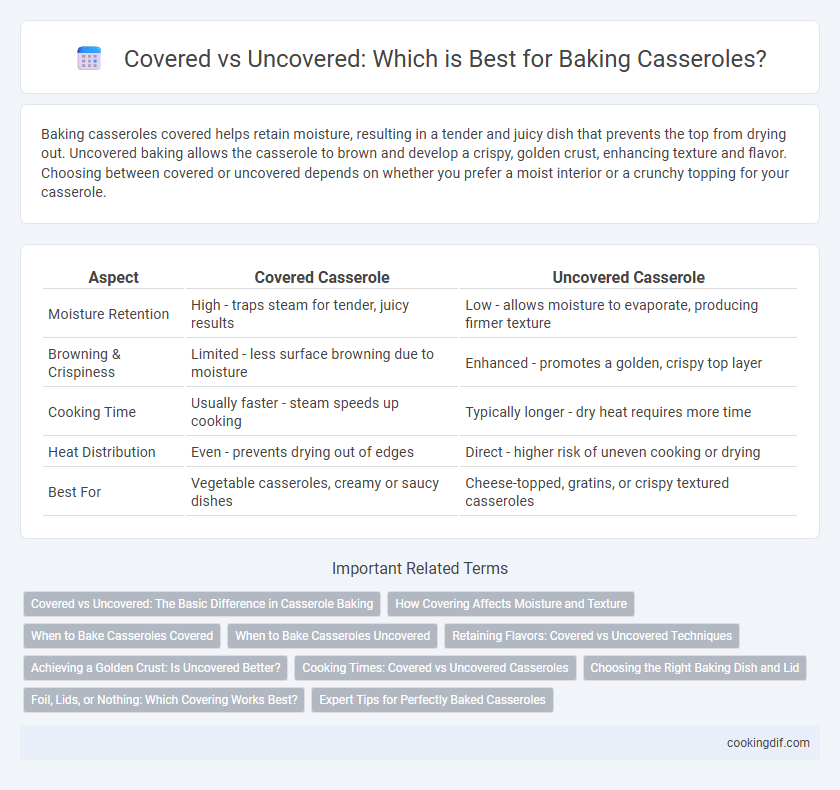Baking casseroles covered helps retain moisture, resulting in a tender and juicy dish that prevents the top from drying out. Uncovered baking allows the casserole to brown and develop a crispy, golden crust, enhancing texture and flavor. Choosing between covered or uncovered depends on whether you prefer a moist interior or a crunchy topping for your casserole.
Table of Comparison
| Aspect | Covered Casserole | Uncovered Casserole |
|---|---|---|
| Moisture Retention | High - traps steam for tender, juicy results | Low - allows moisture to evaporate, producing firmer texture |
| Browning & Crispiness | Limited - less surface browning due to moisture | Enhanced - promotes a golden, crispy top layer |
| Cooking Time | Usually faster - steam speeds up cooking | Typically longer - dry heat requires more time |
| Heat Distribution | Even - prevents drying out of edges | Direct - higher risk of uneven cooking or drying |
| Best For | Vegetable casseroles, creamy or saucy dishes | Cheese-topped, gratins, or crispy textured casseroles |
Covered vs Uncovered: The Basic Difference in Casserole Baking
Covered casseroles retain moisture and heat evenly, resulting in tender, juicy dishes as steam circulates within the covered dish. Uncovered casseroles develop a crispy, browned top layer through direct exposure to dry oven heat, enhancing texture and flavor. Choosing between covered and uncovered baking impacts moisture retention and surface crispness, essential for achieving desired casserole outcomes.
How Covering Affects Moisture and Texture
Covering a casserole during baking traps steam, preserving moisture and resulting in a tender, juicy texture. Baking uncovered allows moisture to evaporate, creating a crispier, browned top layer while potentially drying out the interior. Choosing between covered or uncovered baking depends on the desired balance between moistness and a golden, textured crust.
When to Bake Casseroles Covered
Baking casseroles covered is ideal when the dish requires moisture retention to prevent drying out, such as recipes with dairy, sauces, or meats that need to stay tender. Using a lid or foil cover helps trap steam, ensuring even cooking and preserving flavors, especially during longer baking times. Covered baking is essential for dishes like lasagna, scalloped potatoes, or creamy vegetable bakes to maintain texture and moisture balance.
When to Bake Casseroles Uncovered
Baking casseroles uncovered is ideal when you want a crispy, browned top, especially for dishes with cheese or breadcrumb toppings. Uncovered baking allows moisture to evaporate, resulting in a firmer texture and enhanced caramelization. Avoid baking uncovered if the casserole contains delicate ingredients that might dry out or require longer cooking times to soften.
Retaining Flavors: Covered vs Uncovered Techniques
Covering casseroles during baking traps steam and moisture, preserving flavors and preventing drying, which is ideal for dishes with delicate ingredients or long cooking times. Baking uncovered allows for caramelization and browning, enhancing texture and concentrating flavors, especially in casseroles with cheese or breadcrumb toppings. Choosing between covered and uncovered techniques depends on balancing moisture retention with desired crust development to optimize the casserole's overall taste profile.
Achieving a Golden Crust: Is Uncovered Better?
Baking casseroles uncovered allows moisture to evaporate, promoting the formation of a golden, crispy crust that enhances texture and flavor. Covered casseroles retain steam and moisture, resulting in a softer, less browned surface. For a perfectly golden crust, removing the cover during the last 10-15 minutes of baking is an effective technique to balance tenderness and crispness.
Cooking Times: Covered vs Uncovered Casseroles
Covered casseroles retain moisture and generally require longer cooking times, typically adding 10 to 15 minutes compared to uncovered versions. Uncovered casseroles allow moisture to evaporate, resulting in faster cooking and a browned, crispy top, often reducing bake time by 10 to 20 minutes. Adjusting cooking times based on whether the casserole is covered or uncovered ensures optimal texture and doneness.
Choosing the Right Baking Dish and Lid
Selecting the appropriate baking dish and lid is crucial for casserole success, as covered casseroles retain moisture and enhance even cooking, while uncovered casseroles develop a crispy, browned top. Ceramic and glass dishes with tight-fitting lids are ideal for covered casseroles to trap steam effectively, whereas metal pans without lids excel for recipes requiring a crunchy crust. Understanding these differences ensures optimal texture and flavor depending on whether moisture retention or browning is desired.
Foil, Lids, or Nothing: Which Covering Works Best?
Using foil as a cover for casseroles helps retain moisture and prevents the top from overbrowning, making it ideal for dishes that require longer baking times. Lids, typically made of glass or ceramic, offer a tighter seal than foil, promoting even cooking and better heat retention, especially in slow-cooked casseroles. Baking uncovered allows the casserole to develop a crispy, golden crust but can lead to drying out if left too long, so this method works best when used in the final stages of baking.
Expert Tips for Perfectly Baked Casseroles
Baking casseroles covered traps steam, ensuring even cooking and preventing the top from drying out, while uncovering during the last 15-20 minutes promotes a golden, crispy crust. Experts recommend starting with a tightly covered dish to maintain moisture and finishing uncovered to enhance texture and flavor. Using foil or a tight-fitting lid balances moisture retention and browning, resulting in a perfectly baked casserole every time.
Covered vs uncovered for baking casseroles Infographic

 cookingdif.com
cookingdif.com